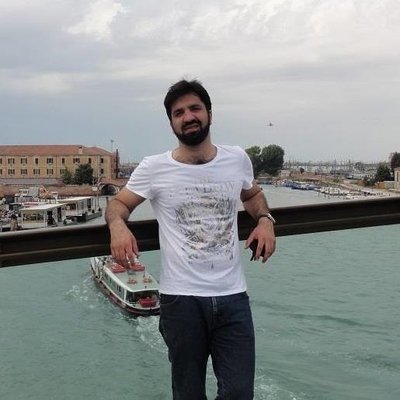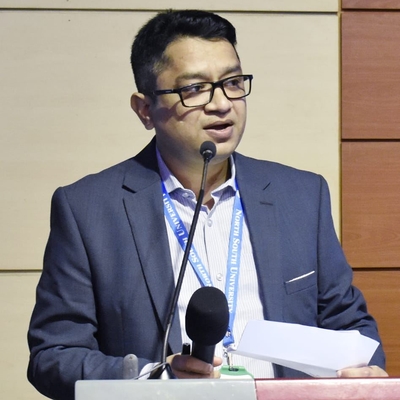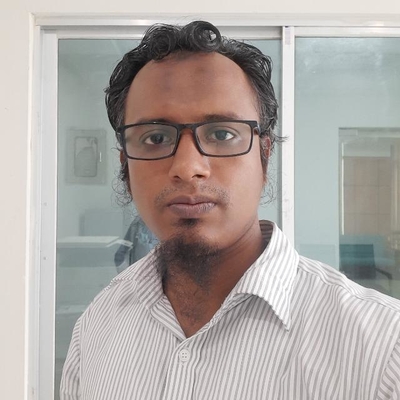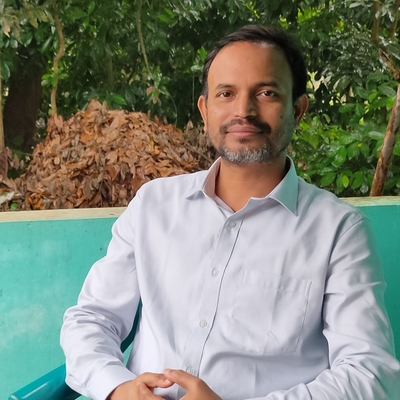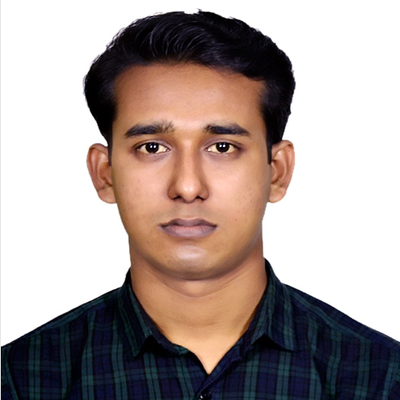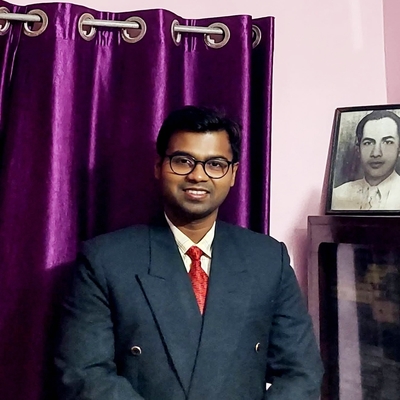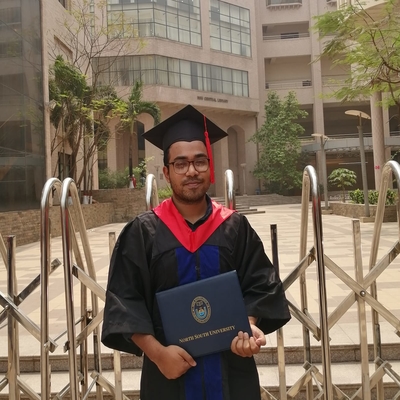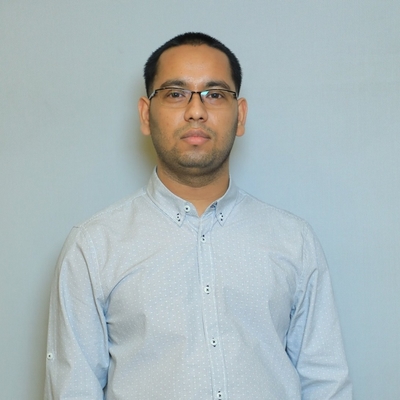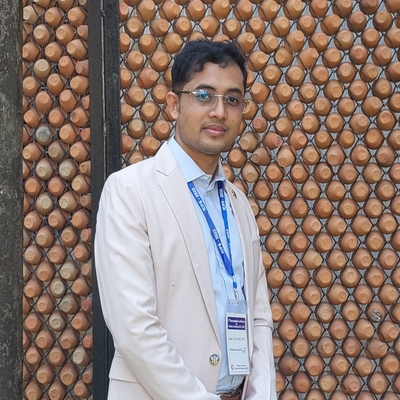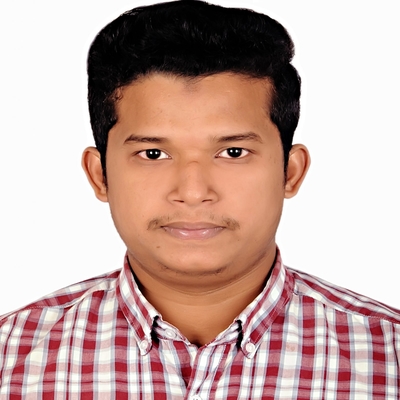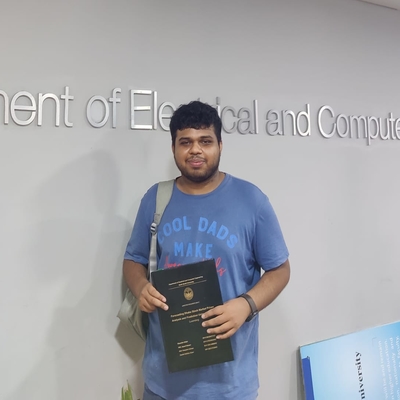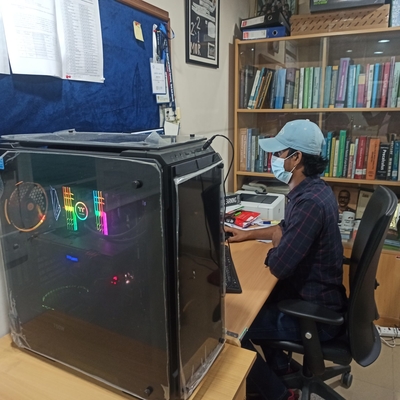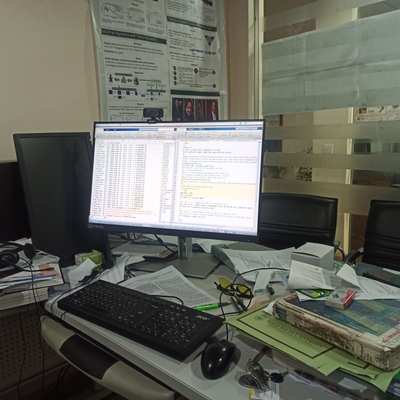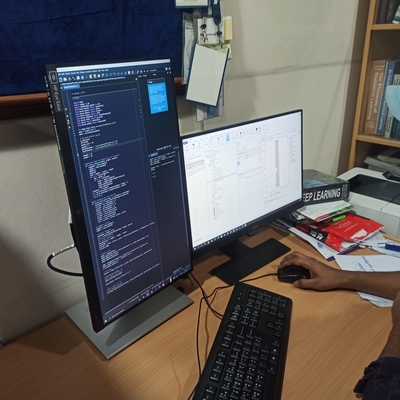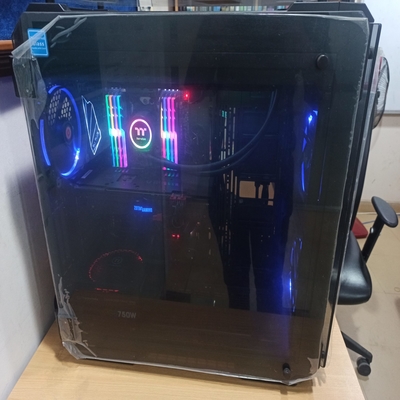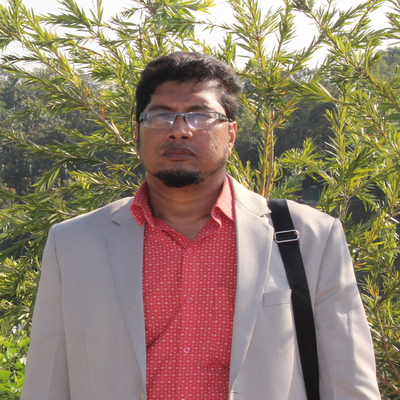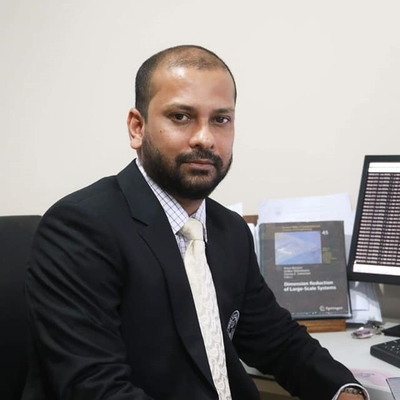
DR. MOHAMMAD MONIR UDDIN
ASSOCIATE PROFESSOR
NORTH SOUTH UNIVERSITY
ABOUT ME
I received my PhD in Mathematics from Max Planck Institute (MPI) for Dynamics of Complex Technical Systems Magdeburg, Germany in 2015. During my PhD Research (2011-2015), I was a member of the International Max Planck Research School for Advanced Methods in Process and Systems Engineering Magdeburg, Germany (2012-2015). I completed my second M.Sc. in Applied Mathematics from Stockholm University, Sweden in 2011. I completed my B.Sc. (2003) and M.Sc. (2005) in Mathematics from the University of Chittagong, Bangladesh. Additionally, I worked as a research fellow in the Department of Mathematics at Stockholm University and also in the Department of Mathematics in Industry and Technology (MIIT) at Chemnitz University of Technology, Germany. I am currently an Associate Professor in the Department of Mathematics and Physics at North South University, Bangladesh. I also have teaching and research experience at various Universities in home and abroad. I have published around 40 research articles in internationally reputed journals and conferences. I am the author of the book titled Computational methods for Approximation of Large-Scale Dynamical systems published bu CRC Press (Taylor & Francis Group) in May 2019.
EDUCATION & EXPERIENCE
Associate Professor
Department of Mathemtics & physics, North South Univarsity, Dhaka, Bangladesh.
Assistant professor
Department of Mathemtics & physics, North South Univarsity, Dhaka, Bangladesh.
PhD in Mathematics
Master of Science in Applied Mathematics
Lecturer of Mathematics
Master of Scinece in Pure Mathematics
Bachelor of Scinece in Mathematics & Subsidiary: Physics, Statistics and Economics
TEAM MEMBER
PUBLICATIONS & TALKS
BOOK
1.
Computational Methods for Approximation of Large-Scale Dynamical Systems
- Author: Mohammad Monir Uddin
- Edition:1st Edition
- First Published: 2019
- eBook Published: 15 May 2019
- Pub. Location: Boca Raton
- Imprint: Chapman and Hall/CRC
- Pages: 336
- eBook ISBN: 9781351028622
- Subjects: Computer Science, Engineering & Technology, Mathematics & Statistics
Abstract: This book discusses computational techniques for the model reduction of large-scale sparse linear time invariant (LTI) continuous-time systems. The book emphasizes the model reduction of descriptor systems, i.e., the systems whose dynamics obey differential-algebraic equations. For the first-order and second-order LTI systems, we show first-order-to-first-order, second-orderto-first-order and second-order-to-second-order reduction techniques. For the first-order-to-first-order or second-order-to-first-order models, order reduction by the balanced truncation (BT) and the iterative rational Krylov algorithm (IRKA) methods are discussed. For the second-order-to-second-order reduction (i.e., structure preserving model reduction), alongside BT, this book discusses another technique called projection onto the dominant eigenspace of the Gramian (PDEG). We also discuss the low-rank alternating direction implicit (LR-ADI) iteration and the issues related to solving the Lyapunov equation of large-scale sparse LTI systems to compute the low-rank Gramian factors. Note that the low-rank Gramian factors are important ingredients for BT and PDEG-based model reductions. The efficiency and capability of the methods are confirmed by numerical experiments with the data of real-world models.
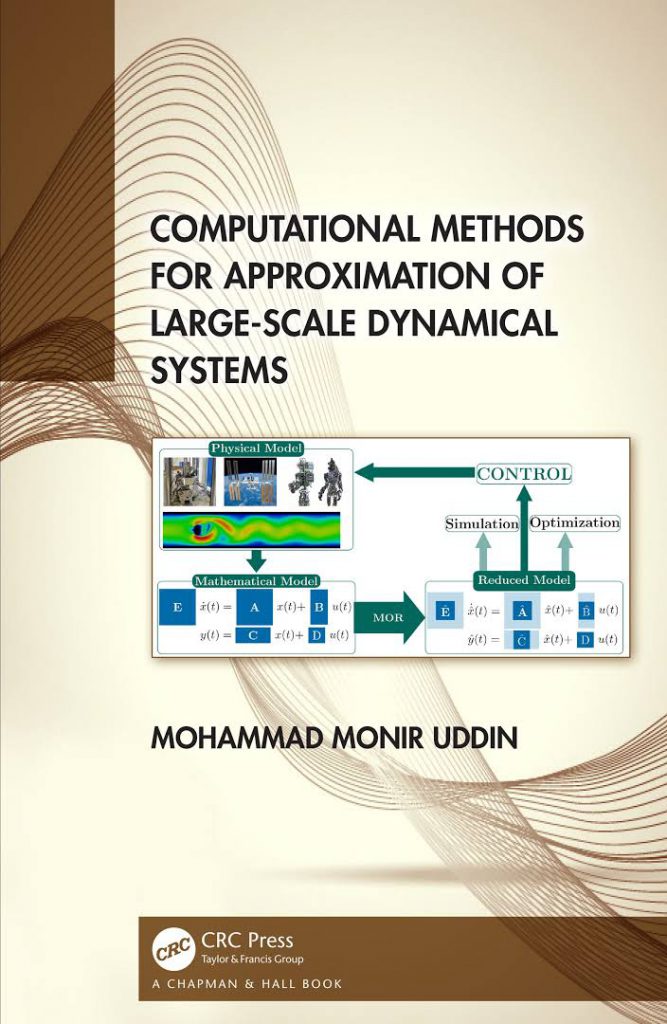
BOOK CHAPTERS
6.
IoT and Computer Vision based Electronic Voting System. Md. Nazmul Islam Shuzan, Mahmudur Rashid, Md. Aowrongajab Uaday, and M. M. Uddin, Advances in Intelligent Systems and Computing (AISC), Spinger, Accepted.
5.
Towards an improved Eigensystem Realization Algorithm for low-error guarantees. Mohammad N. Murshed, Moajjem Hossain Chowdhury, Md. Nazmul Islam Shuzan and M. M. Uddin, and M. Forhad Uddin, 4th International Joint Conference on Advances in Computational Intelligence (IJCACI) (Spniger-Nature), Dhaka, 2020. pp. 12.
4.
Time Restricted Balanced Truncation for Index-I Descriptor Systems with Non-Homogeneous Initial Condition. Kife I. Bin Iqbal1, Xin Du, M. M. Uddin and M. Forhad Uddin, 4th International Joint Conference on Advances in Computational Intelligence (IJCACI) (Spniger-Nature), Dhaka, 2020. pp. 12.
1.
Computational Techniques for Structure Preserving Model Reduction of Constrain Dynamica. M. M. Uddin, Applied Numerical Mathematics, Algorithms for Intelligent Systems (AIS), Spinger, Accepted.
JOURNAL PAPERS
26.
Machine learning-based classification of healthy and impaired gaits using 3D-GRF signals. Md Nazmul Islam Shuzan, Muhammad E.H. Chowdhury, Mamun Bin Ibne Reaz, Amith Khandakar, Farhan Fuad Abir, Md. Ahasan Atick Faisal, Sawal Hamid Md Ali, Ahmad Ashrif A. Bakar, Moajjem Hossain Chowdhury, Zaid B. Mahbub, M. M. Uddin, Mohammed Alhatou, Biomedical Signal Processing and Control, Volume 81, March 2023, 104448.
25.
Comparative study on techniques of model order reduction using rational Krylov subspace method. Md Saiduzzaman, Md Shafiqul Islam, M. M. Uddin, Mohammad Osman Gani, Journal of Interdisciplinary Mathematics, Volume 25, 2022 – Issue 7: Advanced Mathematical Models for Sustainable Technologies.
24.
Generation of the mathematical model to analyze the dynamical behavior of the blood flow. Md Shafiqul Islam, Kife I Bin Iqbal, Md. Saiduzzaman, M. M. Uddin, Mohammad Osman Gani, Journal of Interdisciplinary Mathematics, Volume 25, 2022 – Issue 7: Advanced Mathematical Models for Sustainable Technologies.
23.
Sparsity-Preserving Two-Sided Iterative Algorithm for Riccati-Based Boundary Feedback Stabilization of the Incompressible Navier–Stokes Flow. Md. T. Islam, M. Uddin, M. M. Uddin, Md. A. H. Khan, Md. T. Hossain, Mathematical Problems in Engineering, November 2022, Vol. 2022.
22.
Comparative Mathematical Study of Blood Flow Through Stenotic and Aneurysmatic Artery with the Presence and Absence of Blood Clots. M. N. Uddin, M. M. Uddin, M. M. Alam, Malaysian Journal for Mathematical Sciences, September 2022, Vol. 16, No. 3.
21.
Wavelet and Spectral Analysis of Normal and Abnormal Heart Sound for Diagnosing Cardiac Disorders. Sharif Uddin, Parinda Rahman, Meratun Junnut Anee, Md Mehedi Hasan Rifat, M. M. Uddin, BioMed Research International (2022).
20.
Towards an Adaptive Dynamic Mode Decomposition. Mohammad N.Murshed, M. M. Uddin, Results in Control and Optimization (2022) Volume 6, 100076.
19.
Computational techniques for H2 optimal frequency-limited model order reduction of large-scale sparse linear systems. Xin Du, Kife I. Bin Iqbal, M. M. Uddin, A. Mostakim Fony, Md. Tanzim Hossain, Mian Ilyas Ahmad, and Mohammaed Sahadat Hossain, Journal of Computational Science (2021):101473.
18.
SVD-Krylov based Sparsity-preserving Techniques for Riccati-based Feedback Stabilization of Unstable Power System Models. Mahtab Uddin, M. M. Uddin, M. A. Hakim Khan, M. Tanzim Hossain, Journal of Engineering Advancements, Vol. 02(03) 2021, pp 125-131.
17.
A Novel Non-Invasive Estimation of Respiration Rate From Motion Corrupted Photoplethysmograph Signal Using Machine Learning Model. Md. Nazmul Islam Shuzan, Moajjem Hossain Chowdhury, Md. Shafayet Hossain, Muhammad E. H. Chowdhury, Mamun Ibne Reaz, M. M. Uddin, Amith Khandakar Zaid Bin Mahbub,Sawal Hamid Md. Ali, IEEE Access, Vol. 9, 2021, pp.96775-96790.
16.
SVD-Krylov based techniques for structure-preserving reduced order modelling of second-order systems. M. M. Rahman, M. Uddin, M. M. Uddin, LS Andallah, Mathematical Modelling and Control, Vol. 1(2), 2021, pp.79-89.
15.
Iterative Rational Krylov Algorithms for model reduction of a class of constrained structural dynamic system with Engineering applications. Xin Du, M. M. Uddin, A. Mostakim Fony, Md. Tanzim Hossain and Md. Nazmul Islam Shuzan, Numerical Algebra, Control & Optimization, Vol. , 2021, pp.. -.
14.
Structure preserving model order reduction of a class of second-order descriptor systems via balanced truncation. M. M. Uddin, Applied Numerical Mathematics Vol. 152, 2020, pp.. 185-198.
13.
Estimating Blood Pressure from the Photoplethysmogram Signal and Demographic Features Using Machine Learning Techniques. M. H. Chowdhury, Md N. Islam Shuzan, M. E. H. Chowdhury, Z. B. Mahbub, M. M. Uddin, A. Khandakar, M. Bin Ibne Reaz. Sensors, vol. 20 (11), 2020, pp. 3127.
12.
Tangential interpolatory projections for a class of second-order index-1 descriptor systems and application to Mechatronics. Md. Motlubar Rahman, M. M. Uddin, L. S. Andallah and Mahtab Uddin. Production Engineering, vol. 6, 2020, pp. 577-586.
11.
Interpolatory Projection Techniques for H2 Optimal Structure-Preserving Model Order Reduction of Second-Order Systems. Md. Motlubar Rahman, M. M. Uddin, L. S. Andallah and Mahtab Uddin. Advances in Science, Technology and Engineering Systems Journal, vol. 5(4), 2020, pp. 715-723.
10.
Structure Preserving Model Order Reduction of a Class of Second-Order Descriptor Systems via Balanced Truncation. M. M. Uddin, Applied Numerical Mathematics, Vol., 2019.
9.
Model Reduction of Second-Order Systems by Projecting onto the Dominant Eigenspace of the Gramians. S. Hasan and M. M. Uddin, Journal of Modeling and Optimization, Vol. 10(2), pp. 94-103, 2019.
8.
Iterative methods for solving large sparse Lyapunov equations and application to model reduction of index 1 DAEs. M. Sumona Hossain and M. M. Uddin, Numerical Algebra, Control and Optimization (AIMS), Vol. 9(2), pp. 173-186, 2019.
7.
Gramian-based model-order reduction of constrained structural dynamic systems. M. M. Uddin, IET Control Theory & Applications, Vol. 12(17), pp. 2337-23456, 2018.
6.
Efficient techniques to solve the periodic projected Lyapunov equations and model reduction of periodic systems. M. Sahadat Hossain and M. M. Uddin, Mathematical Problems in Engineering, Vol. 2017, 11 pages, 2017.
5.
Structure preserving mor for large sparse second order index 1 systems and application to a mechatronic model. P. Benner, J. Saak, and M. M. Uddin, Mathematical and Computer Modelling ofDynamical Systems, Tailor & Francis, Vol. 22 (6), 2016, pp. 509–523.
4.
Balancing based model reduction for structured index 2 unstable descriptor systems with application to flow control. P. Benner, J. Saak, and M. M. Uddin, Numerical Algebra, Control and Optimization (AIMS), 5(1), pp. 1-20, 2016.
3.
Reduce Order Modelling of Power System Models Using Interpolatory Projections Technique. M.S Hossain, and M. M. Uddin, International Journal of Modeling and Optimization 5 (3), pp. 228-233, 2015.
2.
Efficient reduced order state space model computation for a class of second order index one system. M. M. Uddin, J. Saak, B. Kranz, and P. Benner. PAMM, Vol. 12 , 2012, pp. 699–700.
1.
Computation of a compact state space model for an adaptive spindle head configuration with piezo actuators using balanced truncation. M. M. Uddin, J. Saak, B. Kranz, and P. Benner. Production Engineering (Spinger), Vol. 6 (6), 2012, pp. 577–586.
CONFERENCE PAPERS
17.
Estimating Aerodynamic Data via Supervised Learning. Azizul Haque, Md. Tanzim Hossain, Mohammad N. Murshed, Kife Intasar Bin Iqbal, and M. M. Uddin, 2022 25th International Conference on Computer and Information Technology (ICCIT), pp. 67-71. IEEE, 2022.
16.
Stability Preservation of Frequency Limited Balancing Based Reduced Order Model of LargeScale Index-1 Descriptor System. Kife I. Bin Iqbal, M. M. Uddin and M. Forhad Uddin. 11th International Conference on Electrical and Computer Engineering (ICECE), IEEE, Dhaka, 2020. pp. 4.
15.
Low-rank approximation of the turbulent channel flow by filter reinforced Dynamic Mode Decomposition. N. Murshed and M. M. Uddin, 23rd International Conference on Computer and Information Technology (ICCIT), IEEE, Dhaka, 2020. pp. 5.
14.
In search of frequency-limited low-rank Gramian factors for the balancing based model reduction of large-scale sparse descriptor system. Kife I. Bin Iqbal, M. M. Uddin and M. Forhad Uddin. In 23rd International Conference on Computer and Information Technology (ICCIT) (IEEE), 2020. pp. 5.
13.
Time delay coordinate based Dynamic Mode Decomposition of a compressible signal. Mohammad N. Murshed and M. M. Uddin, 22nd International Conference on Computer and Information Technology (ICCIT), Accepted to be published in IEEE Xplore, 2019.
12.
An Analysis on Python Programming Language Demand and its Recent Trend in Bangladesh. Aaquib Javed, M. M. Uddin, 22nd International Conference on Computer and Information Technology (ICCIT), Accepted to be published in ACM Digital Library, 2019.
11.
Riccati based optimal control for linear quadratic regulator problems. Mahtab Uddin, M. A. Hakim Khan, and M. M. Uddin, 5th International Conference on Advances in Electrical Engineering 2019 (ICAEE 2019), Accepted to be published in IEEE Xplore, 2019.
10.
Efficient computation of Riccati-based optimal control for power system models. Mahtab Uddin, M. A. Hakim Khan, and M. M. Uddin, 22nd International Conference on Computer and Information Technology (ICCIT), Accepted to be published in IEEE Xplore, 2019.
9.
Reduced Model Based Feedback Stabilization of Large-scale Sparse Power System Model. S. Hasan, A. M. Fony and M. M. Uddin, 2019 International conference on Electrical, Computer and Communication Engineering (ECCE ), IEEE, pp. 1-6, 2019.
8.
Optimal Control of Sensor Based Human Arm Motion and Gesture Replication System. S. Amir, M. S. Kamal, M. M. Uddin, K. M. A. Salam, 2019 IEEE Conference on Systems, Process and Control (ICSPC), IEEE, pp.52–57, 2019.
7.
K-cyclic Smith iterative method for model reduction of index-2 periodic control systems. E. H. Khan, M. S. Hossain, S. G. Omar, A. Tahsin and M. M. Uddin, 2018 International Conference on Innovations in Science, Engineering and Technology (ICISET), IEEE, pp 151-156.
6.
Solution of Large-Scale Lyapunov Matrix Equations for PDEG Based Model Reduction of Structured Dynamical Systems. S. Hassan and M. M. Uddin, 2017 International Conference on Computing , Communication and Sensor Networks (CCSN), pp. 16–19, 2017.
5.
Structure preserving model order reduction using the projection onto the dominant Eigen-space of the Gramian (PDEG). M. M. Uddin, International Conference on Electrical, Computer and Communication Engineering (ECCE ), IEEE, pp. 197–202, 2017.
4.
RKSM for solving the Lyapunov equations of index-1 descriptor systems and application to balancing based model reduction. M. Sumon Hossain, M. Forhad Uddin and M. M. Uddin, 2016 International Conference on Electrical and Computer Engineering (ICECE), IEEE, pp. 451- 454, 2016.
3.
Reduced-order modeling of index-1 vibrational systems using interpolatory projections. P. Benner, J. Saak and M. M. Uddin, 2016 International Conference On Computer and Information Technology (ICCIT), IEEE, pp. 134-138, 2016.
2.
odellreduktion fr strukturierte Index-3-Systeme. J. Saak, M. M. Uddin and M. Voigt. 2013 Tagungsband des GMA-Fachausschusses 1.30, Modellbildung, Identifikation und Simulation in der Automatisierungstechnik Technische Universit ̈t Darmstadt, Institut fo ̈r Automatisierungstechnik und Mechatronik, pp. 180–190, 2013.
1.
Second order to second order balancing for index-1 vibrational systems. P. Benner, J. Saak and M. M. Uddin, 2012 International Conference on Electrical and Computer Engineering (ICECE), IEEE, pp. 933–936, 2012.
POSTER PRESENTATION
3.
Structure preserving model order reduction using the projection onto the dominant Eigen-space of the Gramian (PDEG), M. M. Uddin, International conference on Electrical, Computer and Communication Engineering (ECCE ) 2017, Cox’s Bazar, Bangladesh; 16-18 February 2017.
2.
Model Order Reduction for Structured Second Or-der DAE System,M. I. Ahmad, J. Saak, M. M. Uddin and M. Voigt, Workshop on Non-linear Model Order Reduction 2014, Schloss Ringberg gernsee, Germany, June 2014.
1.
J. Saak, and M. M. Uddin, Balanced Truncation for unstable linearized Navier-Stokes Systems, Workshop on Non-linear Model Order Reduction 2014, Schloss Ringberg Tegernsee, Germany, June 2014.
THESES
TALKS & PRESENTATION
12.
Computational Techniques for Structure Preserving Model Reduction of Constrain Dynamical Models. International Joint Conference on Computational Intelligence, University of Liberal Arts Bangladesh 2019 , 25-26 October, 2019.
11.
Reduced Model Based Feedback Stabilization of Large-scale Sparse Power System Model. International conference on Electrical, Computer and Communication Engineering (ECCE ) 2019, Cox’s Bazar, Bangladesh; 07-09 February, 2019.
10.
Structure preserving model order reduction using the projection onto the dominant Eigen-space of the Gramian (PDEG). International conference on Electrical, Computer and Communication Engineering (ECCE ) 2017, Cox’s Bazar, Bangladesh; 16-18 Feb., 2017.
9.
Rational Krylov subspace method (RKSM) for solving the Lyapunov equations of index-1 descriptor systems and application to balancing based model reduction. 9th International Conference on Electrical and Computer Engineering (ICECE) 2016, Dhaka, Bangladesh, 20-22 Decem, 2016.
8.
Reduced-order modeling of index-1 vibrational systems using interpolatory projections. 19th International Conference On Computer and Information Technology (ICCIT) 2016, Dhaka, Bangladesh, 18-20 Decm., 2016.
7.
Two Competitive techniques for Reduced State Space Modeling of Time-Invariant Large-Scale Continuous-Time stems. 19th International Math Conference 2015, Dhaka, Bangladesh, 18-20 December 2015.
6.
Balancing Based Model Reduction of Unstable Descriptor Systems. 7th IMPRS Workshop 2014, Wernigerode, Germany; 23-25 April, 2014.
5.
Dimension Reduction of Large-Sparse Second Order Descriptor Systems. 6th IMPRS Workshop 2013, Wittenberg, Germany; 8-9 April, 2013.
4.
Second Order to Second Order Balancing for Index-1 Vibrational Systems. 7th International Conference on Electrical & Computer Engineering (ICECE), Dhaka, Bangladesh; 20-22 December, 2012.
3.
Efficient Methods for Reduced Order State Space Modeling of Piezo-Mechanical Systems. GAMM Work-shops 2012: Dynamics and Control, Anif/Salzburg, Austria, 18-21 September, 2012.
2.
Model Reduction of Mechanical Systems with Piezo Actuators Using Balanced Truncation. CSC seminar, MPI Magdeburg, Magdeburg, Germany, 07 February, 2012 .
1.
Model Reduction for Piezo-mechanical Systems Using Balanced Truncation. Stockholm University, Stockholm, Sweden, 29 April, 2011.
RESERACH & PROJECTS
- Control Theory
- Model Order Reduction
- Numerical Linear Algebra
- Scientific Computing
- Deep Learning
Control theory is a field of control engineering and applied mathematics that deals with the control of dynamical systems in engineered processes and machines. The objective is to develop a model or algorithm governing the application of system inputs to drive the system to a desired state, while minimizing any delay, overshoot, or steady-state error and ensuring a level of control stability; often with the aim to achieve a degree of optimality.
To do this, a controller with the requisite corrective behavior is required. This controller monitors the controlled process variable (PV), and compares it with the reference or set point (SP). The difference between actual and desired value of the process variable, called the error signal, or SP-PV error, is applied as feedback to generate a control action to bring the controlled process variable to the same value as the set point. Other aspects which are also studied are controllability and observability. Control theory is used in control system engineering to design automation that have revolutionized manufacturing, aircraft, communications and other industries, and created new fields such as robotics.
Extensive use is usually made of a diagrammatic style known as the block diagram. In it the transfer function, also known as the system function or network function, is a mathematical model of the relation between the input and output based on the differential equations describing the system.
Read more
Many modern mathematical models of real-life processes pose challenges when used in numerical simulations, due to complexity and large size (dimension). Model order reduction aims to lower the computational complexity of such problems, for example, in simulations of large-scale dynamical systems and control systems. By a reduction of the model's associated state space dimension or degrees of freedom, an approximation to the original model is computed which is commonly referred to as a reduced order model.
Reduced order models are useful in settings where it is often unfeasible to perform numerical simulations using the complete full order model. This can be due to limitations in computational resources or the requirements of the simulations setting, for instance real-time simulation settings or many-query settings in which a large number of simulations needs to be performed. Examples of Real-time simulation settings include control systems in electronics and visualization of model results while examples for a many-query setting can include optimization problems and design exploration. In order to be applicable to real-world problems, often the requirements of a reduced order model are:
A small approximation error compared to the full order model.
Conservation of the properties and characteristics of the full order model (E.g. stability and passivity in electronics).
Computationally efficient and robust reduced order modelling techniques.
It is interesting to note that in some cases (e.g. constrained lumping of polynomial differential equations) it is possible to have a null approximation error, resulting in an exact model order reduction.
Read more
Numerical linear algebra, sometimes called applied linear algebra, is the study of how matrix operations can be used to create computer algorithms which efficiently and accurately provide approximate answers to questions in continuous mathematics. It is a subfield of numerical analysis, and a type of linear algebra. Computers use floating-point arithmetic and cannot exactly represent irrational data, so when a computer algorithm is applied to a matrix of data, it can sometimes increase the difference between a number stored in the computer and the true number that it is an approximation of. Numerical linear algebra uses properties of vectors and matrices to develop computer algorithms that minimize the error introduced by the computer, and is also concerned with ensuring that the algorithm is as efficient as possible.
Common problems in numerical linear algebra include obtaining matrix decompositions like the singular value decomposition, the QR factorization, the LU factorization, or the eigendecomposition, which can then be used to answer common linear algebraic problems like solving linear systems of equations, locating eigenvalues, or least squares optimisation. Numerical linear algebra's central concern with developing algorithms that do not introduce errors when applied to real data on a finite precision computer is often achieved by iterative methods rather than direct ones. Read more
Computational science, also known as scientific computing or scientific computation (SC), is a rapidly growing multidisciplinary field that uses advanced computing capabilities to understand and solve complex problems. It is an area of science which spans many disciplines, but at its core it involves the development of models and simulations to understand natural systems.
Algorithms (numerical and non-numerical): mathematical models, computational models, and computer simulations developed to solve science (e.g., biological, physical, and social), engineering, and humanities problems.
Computer and information science that develops and optimizes the advanced system hardware, software, networking, and data management components needed to solve computationally demanding problems.
The computing infrastructure that supports both the science and engineering problem solving and the developmental computer and information science.
Deep learning is part of a broader family of machine learning methods, which is based on artificial neural networks with representation learning. Learning can be supervised, semi-supervised or unsupervised. Deep-learning architectures such as deep neural networks, deep belief networks, deep reinforcement learning, recurrent neural networks, convolutional neural networks and transformers have been applied to fields including computer vision, speech recognition, natural language processing, machine translation, bioinformatics, drug design, medical image analysis, climate science, material inspection and board game programs, where they have produced results comparable to and in some cases surpassing human expert performance.
The adjective "deep" in deep learning refers to the use of multiple layers in the network. Early work showed that a linear perceptron cannot be a universal classifier, but that a network with a nonpolynomial activation function with one hidden layer of unbounded width can. Deep learning is a modern variation that is concerned with an unbounded number of layers of bounded size, which permits practical application and optimized implementation, while retaining theoretical universality under mild conditions. In deep learning the layers are also permitted to be heterogeneous and to deviate widely from biologically informed connectionist models, for the sake of efficiency, trainability and understandability. Read more
BANBEIS

Developing Mathematical Algorithms and Softwares for the Model Reduction of Large-Scale Dynamical Systems. (MS20191055)
- Funded by: Bangladesh Ministry of Education (BANBEIS)
- Principle Investigator: Dr. Mohammad Monir Uddin (monir.uddin@northsouth.edu)
- Co-Principle Investigator: Prof Dr. Farahad Uddin (BUET) (forhad@math.buet.ac.bd)
- Duaration: 3 years (Started from November 2019)
Project Lab
Supervisor & Researcher
Project Outcome
Model order reduction (MOR) is considered as an indispensable subject in the different branches of Science, Engineering and Technology. The demand of MOR is increasing everyday in the different branches of Science, Engineering and Technology. The main goal of this research is to develop robust algorithms and software using different prominent methods of the MOR. The possible significant outcomes of this research are as follows.
The algorithms and software developed from this research would be interesting and rewarding materials for further research and development in both academics and industries.
The software can be useful in Industries for the controller design, optimization and simulation of large-scale mathematical models.
With the results of this project besides several journal papers we also can publish a book.
The researches will be benefited tremendously. The project will help them to acquire knowledge in Control theory, Optimizations, Scientific computing, Mathematical Algorithms and Software. They can see how to apply the Mathematical knowledge in the real life applications. Moreover, if necessary the obtained results may help them to obtain PhD or MPhil Degrees.
We have planned to complete the project as the following steps
1st year: Literature Review, understanding the problems and developing some fundamental algorithms and software.
2nd year: Developing algorithms and software for the model reduction of model reduction of large-scale descriptor systems, some numerical experiments and pressing in conferences.
3rd year: Numerical experiments with the rigorous data in a high performance computer lab and preparing and submitting papers and book for publications.
Sumulation & Results
Publications
-
Kife Intasar Bin Iqbal, Error Minimization of Reduced Models of Large-Scale Systems by Solving Time and Frequency Restricted Lyapunov Equations, Master’s thesis, BUET, Dhaka, Bangladesh, 2021.
http://lib.buet.ac.bd:8080/xmlui/bitstream/handle/123456789/5919/Full%20Thesis.pdf -
Md. Toriqul Islam, Computational Techniques for Riccati-based Feedback Stabilization of Large-scale Sparse Index-2 Descriptor System, Master’s thesis, BUET, Dhaka, Bangladesh, 2022.
http://lib.buet.ac.bd:8080/xmlui/handle/123456789/6160
-
Md. Motlubar Rahman, M. M. Uddin, L. S. Andallah, Mahtab Uddin, Tangential interpolatory projections for a class of second-order index-1 descriptor systems and application to Mechatronics, Production Engineering, 15(1), 2021, pp. 9-19.
DOI: https://doi.org/10.1007/s11740-020-00995-4 -
Xin Du, Kife I. Bin Iqbal, M. M. Uddin, A. Mostakim Fony, Md. Tanzim Hossain, Mian Ilyas Ahmad, and Mohammad Sahadet Hossain, Computational techniques for H2 optimal frequency-limited model order reduction of large-scale sparse linear systems, Journal of Computational Science, 55, 2021, pp. 101473.
DOI: https://doi.org/10.1016/j.jocs.2021.101473 Kife I. Bin Iqbal, Xin Du, M. M. Uddin and Md. Tanzim Hossain , Frequency and time-limited model reduction of index-2 DAEs with application to Blood flow through carotid, Under review in Computers and Mathematics with Applications.
-
Kife I. Bin Iqbal, M. M. Uddin and M. Forhad Uddin, Stability Preservation of Frequency-Limited Balancing Based Reduced Order Model of LargeScale Index-1 Descriptor System, 11th International Conference on Electrical and Computer Engineering (ICECE), IEEE, Dhaka, 2020. pp. 4.
DOI: https://ieeexplore.ieee.org/abstract/document/9393106 -
Kife I. Bin Iqbal, M. M. Uddin and M. Forhad Uddin , In search of frequency-limited low-rank Gramian factors for the balancing based model reduction of large-scale sparse descriptor system, In 23rd International Conference on Computer and Information Technology (ICCIT) (IEEE), 2020. pp. 5.
DOI: https://ieeexplore.ieee.org/abstract/document/9392667 -
Kife I. Bin Iqbal, M. M. Uddin and M. Forhad Uddin , Time Restricted Balanced Truncation for Index-I Descriptor Systems with Non-Homogeneous Initial Condition, In 4th International Joint Conference on Advances in Computational Intelligence (IJCACI) (Springer-Nature), Dhaka, 2020. pp. 12.
DOI: https://link.springer.com/chapter/10.1007/978-981-16-0586-4_15 -
Aaquib Javed, Md. Sayem Mahmud, Md. Takbir Alam, Md. Foysal Bin Ohab, Khandakar Ratul Ali, Abdullah Al Jobaer and M. M. Uddin, Pothole Detection System Using Region-Based Convolutional Neural Network, In 2021 IEEE 4th International Conference on Computer and Communication Engineering Technology (CCET), pp. 6-11. IEEE, 2021.
DOI: https://doi.org/10.1109/CCET52649.2021.9544396
NSU CTRG 2019-2020

Model Reduction of Second-Order Descriptor Systems over Finite-Frequency Interval (CTRG-19/SEPS/05)
- Funded by: North South University
- Principle Investigator: Dr. Mohammad Monir Uddin (monir.uddin@northsouth.edu)
- Co-Principle Investigator: Dr. Xin Du (duxin@shu.edu.cn)
- Duaration: 1 years (Started from October 2019)
Before implementing new ideas or decisions in different disciplines of science, engineering, and technology, an experiment is required. The classical approach of this experiment would require a laboratory with a lot of new equipment, which is an expensive method to demonstrate a concept. The modern approach, rather less expensive and often easier to apply than experiments, to explore scientific ideas to convince others of their validity is through computer simulation. In simulation, one needs to convert a physical model into a mathematical model. Often also in reallife applications the mathematical models are represented by linear time-invariant (LTI) continuous-time systems. In many cases, these systems are in second-order form i.e., the system are represented by set of second order ordinary differentiaol equations. Sometimes they are subject to additional algebraic constraints, leading to differential-algebraic equations (DAEs) or descriptor systems. The mathematical models are generated in many different ways. In many applications, the systems are obtained by finite element (FEM) or finite difference (FDM) discretization. In order to model a system accurately, a sufficient number of grid points must be generated because many geometrical details must be resolved. Sometimes physical systems consist of several bodies and each body is composed of a large number of disparate devices. Therefore, the mathematical models become more detailed and different coupling effects must be included. In either case, the resulting systems are typically very large and sparse. Moreover, often they might be well-structured. A large-scale system leads to additional memory requirements and enormous computational efforts. They also prevent frequent simulations which is often required in many applications. Sometimes, the generated systems are too large to store due to the restriction of computer memory. To circumvent these complexities reducing the size of the systems is unavoidable. The method to reduce a higher dimensional to a lower one is called model order reduction (MOR).
The fundamental aim of MOR is to replace the high dimensional dynamical systems by substantially lower dimensional systems, while the dynamics of the original and reduced systems should be approximated to the largest possible extent. In some cases, some important features such as stability, passivity, definiteness, symmetry and so forth of the original system must be preserved in the reduced systems. There are many techniques for MOR, namely optimal Hankel norm approximation, singular perturbation approximation, dominant subspaces projection, balanced truncation and Iterative rational Krylov Algorithms etc.. Among all the aforementioned methods, currently balanced truncation (BT) is the most commonly used techniques for the model reduction of large-scale dynamical systems. In general the BT method preserves the stability of the original system i.e., if the original system is stable then the reduced model is also stable. Moreover, the method has a global error bound which can be defined prior by an user. That mens the error of the reduced order model can be bounded by providing a tolerance. This prominent method is updated by minimizing the error of the reduced system over a certain frequency interval. In the literature this is known as frequency-limited balanced truncation (FLBT). Currently frequency-limited balanced truncation has taken lot of attentions since in engineering and technology in some applications it is important to minimize the error of the system over a certain frequency interval. Moreover frequency limited balancing based reduced model has meaningful physical interpretation and provides more accurate approximation. The FLBT method is well established for generalized state space model. Recently it is also generalized for second-order standard and first-order descriptor systems. Until now there is no investigation of such model reduction method for second order descriptor systems. This research is mainly devoted to fill this gap.
This project focuses on developing mathematical algorithm for the model reduction of large-scale second-order descriptor systems based on frequency-limited balanced truncation. The efficiency and capability of the proposed method will be checked to apply this to a very large-scale (around 300 0000 dimensional) real world data of a structural FEM model of a micro-mechanical piezo-actuators based adaptive spindle support (ASS). The data of this model is already in our hand which is provided by the Fraunhofer Institute for machine tools and forming technology in Dresden (Germany).
Supervisor & Researcher
Project Outcome
In this project we proposed to develop algorithms for the frequency limited model reduction of large-scale sparse descriptor systems. The proposed research work has been successfully done theoretically and some numerical experiments also have been carried out. The results have been shown in the attached papers. Some numerical experiments are being carried out at a automation lab of Shanghai University, China. The project was supposed to be ended by September 2020. Due to pandemic problem it was delayed by three months. In future work we will generalize the ideas obtained here for limited time interval case.
Sumulation & Results
Publications
- M. M. Uddin: “Computational Techniques for Structure Preserving Model Reduction of Constrain Dynamical Models”, Proceedings of International Joint Conference on Computational Intelligence, Algorithms for Intelligent Systems, Spinger pp. 487–496, 2020 Note: DOI: https://doi.org/10.1007/978-981-15-3607-6-39
- Kife I. Bin Iqbal, Xin Du, M. M. Uddin, M. Forhad Uddin: ’Time restricted balanced truncation for index-I descriptor systems with non-homogeneous initial condition’ International Joint Conference on Advances in Computational Intelligence (IJCACI) 2020, Accepted and presented for publishing in ’Algorithms for Intelligent Systems’ (Spinger).
- Xin Du, M. M. Uddin, A. Mostakim Fony and Md. Tanzim Hossain, Mohammad Sahadat-Hossain: ’Frequency Limited H2 Optimal Morel Reduction of Large-Scale Dynamical Systems’, Under review to the Journal of Computational Science (Elsvier). Available in arXive: https://arxiv.org/abs/2101.04566
- Xin Du, M. M. Uddin, A. Mostakim Fony and Md. Tanzim Hossain, Md. Nazmul Islam Shuzan: ’Iterative Rational Krylov Algorithms for model reduction of a class of constrained structural dynamic system with Engineering applications’, Under review to AIMS Numerical Algebra Control and Optimization. Available in arXive: https://arxiv.org/abs/2101.03053
- Xin Du, M. M. Uddin, A. Mostakim Fony and Md. Tanzim Hossain, Md. Nazmul Islam Shuzan, Mohammad Sahadat-Hossain: ’On the Frequency Limited H2 Optimal Model order Reduction of Large-Scale Dynamical Systems’, submitted and Under review to the International Conference on Information and Communication Technology for Sustainable Development.
NSU CTRG 2020-2021

Approximation of Large-Scale Dynamical System over a Limited Time Interval. (CTRG-20/SEPS/20)
- Funded by: North South University
- Principle Investigator: Dr. Mohammad Monir Uddin (monir.uddin@northsouth.edu)
- Co-Principle Investigator: Mohammad Niaz Morsed (mohammad.murshed@northsouth.edu)
- Duaration: 1 years (Started from March 2021)
Model order reduction (MOR) is considered as an indispensable subject in the different branches of Science, Engineering and Technology. The demand of MOR is increasing everyday in the different branches of Science, Engineering and Technology. Over the last few decades many methods havebeen developed to perform the model reduction of large-scale dynamical system.Every method has advantages and disad- vantages. Currently time and frequencylimited MOR techniques have taken lot of attentions since in engineering and tech-nology in some applications it is important to minimize the error of the system overa finite time and frequency intervals. More- over time and frequency limited MORhas meaningful physical interpretation and provides more accurate approximations.They are already well established for standard/generalized system. Recently, weare investigating the frequency-limited MOR of descriptor systems which is a partof the project funded by NSU-CTRG (2019- 2020). In this work we will investigatethe time limited MOR using the balanced truncation and Interpolatory projectionmethods. The efficiency of the developed methods will be assessed by applying themapplied to some real world data for the MOR of descriptor systems . The possible significant outcomes of this research are as follows:
The algorithms and software developed from this research would be interesting and rewarding materials for further research and development in both academics and industries.
The software can be useful in Industries for the controller design, optimization and simulation of large scale mathematical models.
With the results of this project besides several journal papers we also can publish a book.
The researches will be benefited tremendously. The project will help them to acquire knowledge in Control theory, Optimizations, Scientific computing, Mathematical Algorithms and Software. They can see how to apply the Mathematical knowledge in the real life applications.
Supervisor & Researcher
Project Outcome
In this project we proposed to develop algorithms for the frequency limited model reduction of large-scale sparse descriptor systems. The proposed research work has been successfully done theoretically and some numerical experiments also have been carried out. The results have been shown in the attached papers. Some numerical experiments are being carried out at a automation lab of Shanghai University, China. The project was supposed to be ended by September 2020. Due to pandemic problem it was delayed by three months. In future work we will generalize the ideas obtained here for limited time interval case.
Sumulation & Results
Publications
- Xin Du, Kife I. Bin Iqbal, M. M. Uddin, Md. Tanzim Hossain, and Pawan Goyal: A computationally effective time-restricted stability preserving H2-optimal model order reduction approach.” Results in Control and Optimization 11 (2023): 100217. DOI: https://www.sciencedirect.com/science/article/pii/S266672072300019X
- Kife I. Bin Iqbal, Xin Du, M. M. Uddin, Md. Tanzim Hossain, Mohammad Forhad Uddin, and Umair Zulfiqur: Reduced Order Modeling of a Class of Descriptor System on Certain Domains with the Application to Blood Flow Through the Carotid. DOI: https://papers.ssrn.com/sol3/papers.cfm?abstract_id=4474183
NSU CTRG 2021-2022

Model Order Reduction for Aircraft Wing Shape Optimization (CTRG-21/SEPS/15)
- Funded by: North South University
- Principle Investigator: Dr. Mohammad Monir Uddin (monir.uddin@northsouth.edu)
- Duaration: 1 years (Started from April 2022)
Over the last few decades, enormous researches have been done on WSO which has mainly emphasized the physical model development rather than the generation of the data model. However, the data model is crucial for numerical analysis since it reflects all the characteristics of the physical model and easy to handle for optimization. Due to the presence of redundant data, the smooth computation can never be performed on the unoptimized mathematical model. Therefore, ROM techniques can be applicable to turn the unoptimized data model optimized by reducing the useless dimension from the data model. As a result, the physical model generated from the optimized data model becomes smooth to analyze and gives an optimal geometric shape easily. Dealing with WSO using ROM techniques is a new concept that is excepted to complete flawlessly in this project. The possible significant outcomes of this research are as follows:
The physical model of the aircraft wings will be constructed and data of the shape deformation due to aerodynamic drag will be extracted to generate a mathematical models.
By linearization procedure, the linear state-space formation will be generated based on the input-output relations what will mainly define the properties of the physical model.
ROM of the generated mathematical models will be created in order to truncate the redundant design parameters for boosting up the entire simulation procedures.
Hopefully, an optimized aircraft wing structure will be found from this project, which will be beneficial to use practically in the future.
The project will help to acquire knowledge on WSO in terms of Control theory, Scientific computing, and Mathematical Algorithms.
Several scientific papers will be published in renowned journals highlighting the outcomes of this project.
Supervisor & Researcher
Sumulation & Results
CONTACT ME
DR. MOHAMMAD MONIR UDDIN
ASSOCIATE PROFESSOR
NORTH SOUTH UNIVERSITY
- +880-2-55668200 (Ext: 6212)
- monir.uddin@northsouth.edu
- North South University, Bashundhara R/A, Dhaka - 1229, Bangladesh
- SAC - 1025
- Saturday, Thursday (11AM - 6PM) Sunday, Tuesday - (3PM - 6PM)
